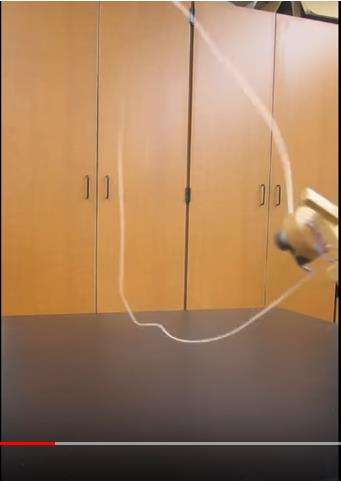Upward Force from Form Drag
Posted: Fri Apr 20, 2018 10:01 pm
Indeed it is. Got some handy? I saw some around here once ...VGB wrote:Science is a wonderful thing
Indeed it is. Got some handy? I saw some around here once ...VGB wrote:Science is a wonderful thing
Graeme,why is the skin drag in the loop not pulling it all the way over the top? Is the loop just too narrow to do that?
2. Because the rho_l*v.^2 tension in the string where the loop joins the rising leg is greater than the weight of the string + the downward skin drag on that leg. The height could be much higher for the tangential velocity he produced, but is limited by the length of his loop.2: When he aims the string straight up, how is the string maintaining a height of ~8'?
3. I don't know how big of mess their would be on the return leg after the loop hits the wall, but assuming it would feed through the pinch rollers ok, then it should shoot towards the wall with a trajectory that would be similar (although maybe not exact because there will be a tension difference) to the case with a loop.Q3: Would you like to predict the outcome of him pointing his string shooter at the wall, destroying the loop? Would the string just fall to the ground straight out of the motors without a loop? Or would the upper leg maintain trajectory initially imparted by the string shooter?
Someone told me that drag can produce lift in the line. I just wanted to make sure the drag on the line wasn't making the loop rise through the air. If you say drag can't pull anything, I guess that other person was wrong.
I don't understand what "pulling it all the way over the top" means, but I don't think drag could pull anything. Drag just opposes the line's movement through the air. Could you expand on the point you are trying to make?
So tension is holding the loop 8 foot up? What's making the rising leg rise? Tension in the loop?2. Because the rho_l*v.^2 tension in the string where the loop joins the rising leg is greater than the weight of the string + the downward skin drag on that leg. The height could be much higher for the tangential velocity he produced, but is limited by the length of his loop.
And how would that trajectory differ? Would it go up, down, faster, slower, straighter, more curved? Without tension from the loop, what will happen?3. ... then it should shoot towards the wall with a trajectory that would be similar (although maybe not exact because there will be a tension difference) to the case with a loop.
I hope Dr Biggens discovers gravity when he does real physics, that would be really cool. Perhaps he will be able to gather a team of the finest minds to look at what happens to tension in the loop when the motor is switched off:gordonjudd wrote: It might work in a vacuum, but that does not explain the difference in the width of the legs and the shape of the loop when he changes the launch angle of the shooter. I would think those changes are only effected by the angle of the forces produced by the skin drag on the line.
If it was just the momentum change at the loop that was producing the tension in the string, then I would think the axis of loop would rotate in the plane that was created at the source of the shooter. It doesn't do that as you can see the loop remains aligned in a vertical plane even though the angle of the shooter was changed as shown here:

Maybe this is another interesting experiment for Dr. John Biggins to explain based on some real physics as he did with the chain fountain.
So what force (or forces) do you think is offsetting the force of gravity on the mass of the spinning loop? It can't be momentum.
Gordy
after watching these videos on youtube I wanted to ask you experts if you think that this phenomenon can be related to the fact that the fly line seems to defy gravity and stay airborne much longer than we would expect when unrolling after the shot, in particular during a distance cast.
Hi David and PaulSo what about the slinky then? Is it true that the lower end doesn't drop due to gravity because the upper end hasn't told it yet?
Given the forums history of trying to read across studies of bead chains, javelins and string shooters to the flight of a fly line, why not throw in a slinky?The slinky issue has nothing to do with the flight of the fly line. It is a completely different problem: different object, different conditions, even if there is some “likeness” in the apparent “aloft” conditions.
A slinky model and a description of the associated dynamics is shown below:Just awesome, I wait eagerly for someone who can write the same for the slinky.
Of course SirThe modeling of the process presented here is also relatively simple and should be accessible to undergraduate students.
Merlin, I am not retired and it is the fishing season, there are only so many tangents that it’s possible to cope with simultaneously and I was interested in Dirks analysis of the snap. Having raised the question, it would have been rude to ignore it and I’m painfully aware of the time video analysis takes.Merlin wrote: A reproof: you should have posted it as soon as David raised his question, then Paul (and others like me), would have understood the wavy aspect of the problem (perhaps).